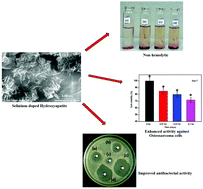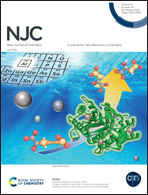Influence of sonication on the physicochemical and biological characteristics of selenium-substituted hydroxyapatites
Abstract
Although the material hydroxyapatite (HAP) has excellent porous, biocompatible, and biodegradable properties, its mechanical strength and microbial inhibition rate are not adequate for its direct use in bone tissue engineering or in constructing artificial teeth. To overcome some of its limitations, in the present study, we have formed an organic–inorganic composite with an altered internal structure via doping selenium (Se) cations into the lattice of HAP. We have synthesized Se-substituted HAP (Se-HAP) composites with different Se/P ratios (0.01, 0.05, and 0.1 M) via a wet chemical route in which two different sets of samples were collected (1) after only precipitation (referred to as the precipitation method) and (2) after precipitation followed by sonication (referred to as the sonochemical method). FTIR and Raman spectroscopic analyses confirmed the successful doping of Se into the HAP matrices, while powder XRD studies indicated their highly crystalline nature, which was significantly influenced by Se doping. The XRD data also showed that the Se-HAP particles formed by the precipitation method have a size of 56 nm and those formed by the sonochemical method have a size of 29 nm. Morphological analysis by means of SEM and TEM indicated that the sonochemical method produces well-defined rod-shaped particles, while the precipitation method produces particles with agglomerated structures. Hemolytic studies confirmed that the Se-HAP particles are biocompatible, and that the hemolytic ratio increases with the Se content. In addition, antibacterial studies indicated that Se-HAP responds quite well against a Gram-positive strain (S. aureus), on a par with the response to a Gram-negative strain (P. aeruginosa). Finally, in vitro cell viability and proliferation studies indicated an increase in the proliferation capacity of non-cancer cells (NIH-3T3 fibroblasts) and a considerable reduction in the viability of cancer cells (MG-63 osteosarcoma). Based on the overall analysis, the Se-HAP samples formed by the sonochemical approach could have potential for biomedical applications in bone cell repair, growth, and regeneration.



 Please wait while we load your content...
Please wait while we load your content...